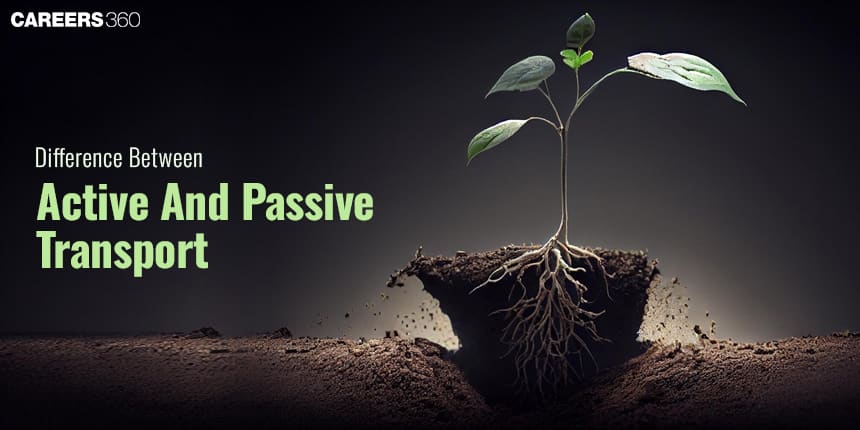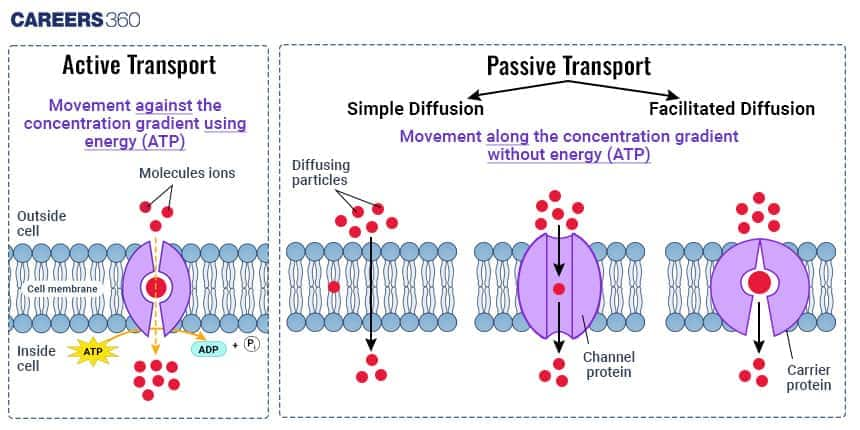Difference Between Active And Passive Transport: Examples, Types
Active and passive transport are the two major mechanisms of molecular movement across cell membranes. Active transport requires energy (ATP) to move molecules against the concentration gradient, while passive transport depends on natural diffusion without energy input. Together, they maintain cellular homeostasis and ion balance.
This Story also Contains
- Introduction
- What is Active Transport?
- Types of Active Transport
- What is Passive Transport?
- Types of Passive Transport
- Comparison between Active and Passive Transport
- Biological Significance
- Active vs Passive Transport NEET MCQs (With Answers & Explanations)
- Recommended Video on Active vs Passive Transport

Introduction
The transport across the cell membrane is one of the significant ways by which the body maintains cellular homeostasis. All these functions require proper cellular mechanisms in transport. Cell membranes regulate transport in major two ways: passive and active transport.
Overview of Membrane Transport
Active and passive transport are primary ways through which living organisms, especially at a cellular level, maintain homeostasis and ensure that the cells function properly. Active transport refers to the transport of molecules against their concentration gradient, therefore it requires energy in the form of ATP. In contrast, there is no need for external energy in passive transport since it runs through spontaneous diffusion processes, whereby substances move according to their concentration gradient.
Role in Cellular Homeostasis
These mechanisms of transport assume an important role in cellular functions such as nutrient uptake, waste removal, and maintenance of ion gradients. This is an energy-driven mechanism essential to maintain ion and other substance concentration differences between the inside and the outside of the cell.

What is Active Transport?
The process by which cells transfer substances from a lower concentration to one of higher concentration i.e., against the normal flow is known as active transport. The nutrients that are present in low amounts outside the cell or the removal of waste products that are present in higher concentrations within the cell depends on this process.
Types of Active Transport
The different types of active transport are:
Primary Active Transport
Direct use of energy in transporting the molecules against their concentration gradient.
Uses special proteins called pumps, which pump ions across the membrane.
Examples include Sodium-Potassium Pump moves 3 sodium ions out of the cell and 2 potassium ions into the cell.
It plays a key role in maintaining both the resting membrane potential of the cell and its volume.
Secondary Active Transport
Uses the energy derived from primary active transport to transport other substances against their gradient.
In symport, the molecules move in the same direction. For example, glucose and sodium.
In antiport, the molecules move in opposite directions. For example sodium-calcium exchanger.
Bulk Transport
Bulk transport is through two main processes:
Endocytosis
Mechanisms by which cells engulf extracellular material.
Includes phagocytosis i.e., engulfing large particles or cells and pinocytosis i.e., intake of liquids and small molecules.
Exocytosis
The vesicle merges with the cell membrane and opens up to the exterior, spilling its contents.
Vesicles carrying substances merge with the plasma membrane, spilling their content into the extracellular space.
What is Passive Transport?
The transfer of molecules across cell membranes without energy input is called passive transport. It builds on the tendency of molecules, by diffusion, to move from an area of high concentration to an area of low concentration. Since no external energy is required in passive transport, it makes up a basic mechanism that helps the cell maintain equilibrium and carry out important functions.
Types of Passive Transport
In passive transport, there is no energy requirement for the movement of molecules across the plasma membrane. It is the movement of molecules from an area with a higher concentration to an area with a lower concentration to form an equilibrium.
Simple Diffusion
In simple diffusion, the movement of molecules occurs from an area of high concentration to one of low concentration across a lipid bilayer.
The molecules move directly across the phospholipid bilayer of the membrane.
Examples include, oxygen and carbon dioxide diffuse across respiratory membranes.
Facilitated Diffusion
In facilitated diffusion, the movement of molecules across a membrane is aided by specific transport proteins that do not expend energy.
Allow larger or polar molecules to pass through the membrane as they cannot diffuse directly through the lipid bilayer.
Examples include glucose transported into the cell via GLUT transporters.
Osmosis
Osmosis is a type of facilitated diffusion in which water moves through a semipermeable membrane.
Balances the water level in the cell and the turgor pressure, which is beneficial for the functioning and stability of the cell.
Examples include uptake of water by plant roots, maintenance of water balance in red blood cells.
Comparison between Active and Passive Transport
It is one of the important difference and comparison articles in biology. The differences between active and passive transport are listed below:
Aspect of Difference | Active Transport | Passive Transport |
Energy Requirement | Requires energy (ATP) | Does not require energy |
Direction of Movement | Against the concentration gradient (low to high) | Along the concentration gradient (high to low) |
Involvement of Proteins | Always involves carrier proteins | May or may not involve carrier proteins |
Speed | Slower due to energy dependency | Generally faster as no energy is needed |
Examples | Sodium-potassium pump, proton pump | Diffusion, osmosis, facilitated diffusion |
Role in Cells | Helps in nutrient uptake and waste removal | Maintains equilibrium and supports passive absorption |
Specificity | Highly specific, involves specific transport proteins | Can be less specific, depending on molecule size/gradient |
Energy Source | ATP or other energy forms | Concentration or electrochemical gradient |
Directionality | Unidirectional | Can be bidirectional |
Dependency on Gradient | Independent of the concentration gradient | Dependent on the concentration gradient |
Rate Control | Controlled by energy supply | Controlled by the concentration gradient |
Cellular Examples | Uptake of glucose in intestines, ion pumps | Gas exchange, water movement in cells |
Transport Mechanism | Active process using metabolic energy | Passive process without metabolic energy |
Occurrence | Occurs only in living cells | This can occur in both living and non-living systems |
Impact on Cell Energy | Depletes cellular energy | Does not affect cellular energy |
Biological Significance
Passive transport plays a significant role in many physiological and ecological processes:
Role in Nutrient Uptake and Waste Removal
Cells take up essential nutrients like glucose, other sugars, amino acids, etc., required for metabolism and energy production. Excrete waste products of metabolism to maintain the stability of the internal environment
Maintenance of Ion Concentration
The transport mechanisms help maintain proper ion gradients across cell membranes, which are vital for cellular functions such as nerve impulse transmission, muscle contraction and enzyme activity.
Regulation of Osmotic Pressure
Osmosis plays a crucial role in balancing water movement between the cell and its surroundings. This regulation of osmotic pressure prevents cells from bursting in hypotonic environments or shrinking in hypertonic conditions.
Active vs Passive Transport NEET MCQs (With Answers & Explanations)
The key concepts to be covered under this topic for different exams are:
Types of Active Transport
Types of Passive Transport
Active vs Passive Transport
Practice Questions for NEET
Q1. Which of the following statements regarding membrane transport is false?
Polar and charged solutes will not cross cell membranes effectively without specific protein carriers.
Each protein carrier will only bind and transport one (or a few very similar) types of solute.
Sugars such as glucose are always transported by active transport rather than by facilitated diffusion carriers.
Ions are typically transported by special proteins that form membrane channels.
Correct answer: 3) Sugars such as glucose are always transported by active transport rather than by facilitated diffusion carriers.
Explanation:
Sugars such as glucose can be transported by both active transport and facilitated diffusion carriers, depending on the specific context and the concentration gradient of the sugar.
Active transport and facilitated diffusion are two different mechanisms used for transporting molecules across cell membranes. In the case of glucose, both mechanisms are involved in its transport, depending on the concentration gradient and cellular requirements.
Active transport of glucose occurs when the concentration of glucose inside the cell needs to be increased against its concentration gradient. This process requires the expenditure of energy, typically in the form of ATP, to move glucose molecules from an area of lower concentration to an area of higher concentration.
Facilitated diffusion, on the other hand, does not require energy input and relies on the concentration gradient of the sugar. Facilitated diffusion carriers, such as glucose transporters (GLUT proteins), assist in the transport of glucose down its concentration gradient across the cell membrane. These transporters facilitate the movement of glucose molecules by undergoing conformational changes.
In certain situations, the transport of glucose may predominantly rely on active transport, such as in the absorption of glucose in the intestines or reabsorption in the kidneys, where glucose needs to be transported against its concentration gradient.
However, in many other tissues and cells, facilitated diffusion carriers play a significant role in glucose transport. For example, GLUT proteins are responsible for the facilitated diffusion of glucose in various cells, including muscle, adipose tissue, and the brain.
To summarize, the transport of sugars like glucose can occur through both active transport and facilitated diffusion carriers, depending on the specific conditions and requirements of the cell or tissue. Therefore, statement C is wrong.
Hence, the correct answer is option 3) Sugars such as glucose are always transported by active transport rather than by facilitated diffusion carriers.
Q2. Active transport uses the energy from_________ to transport the molecules from outside to inside across a membrane.
Cyclic AMP
Phloroglucinol
Acetyl chlorine
ATP
Correct answer: 4) ATP
Explanation:
Active transport mechanisms require the use of cellular energy, primarily in the form of adenosine triphosphate (ATP) which is itself formed through secondary active transport using a hydrogen ion gradient in the mitochondria.
Hence, the correct answer is option 4) ATP.
Q3. Passive absorption of water by the root system is the result of
Osmotic force in the shoot system
Tension on the cell sap due to transpiration
Forces created in the cells of the root
Increased respiratory activity in root cells
Correct answer: 2) Tension on the cell sap due to transpiration
Explanation:
Negative pressure from transpiration in the shoot system leads to the passive absorption of water in plants. As leaves lose water, osmotic pressure in the mesophyll cells increases, and thus it pulls water from the adjacent cells with tension. This tension tugs water out of the elements of the midrib of a leaf down through the stem, and lastly from the roots, which serve as passive pathways only to absorb water into the stem in an energy-saving mode.
Hence, the correct answer is option 2) Tension on the cell sap due to transpiration.
Also Read:
Recommended Video on Active vs Passive Transport
Frequently Asked Questions (FAQs)
Active transport requires energy to move substances against their concentration gradient, whereas passive transport doesn't require energy and is always directed along the gradient of the concentration.
Simple diffusion, facilitated diffusion, for example, the uptake of glucose by transport proteins, and osmosis, for instance, the balance of water in cells.
The sodium-potassium pump is a primary active transport mechanism that pumps the sodium ions out of the cell and the potassium ions into the cell into the cell. In doing so, due to the energy from ATP, it maintains the vital ion gradients.
Transport proteins facilitate the movement of a specific molecule across the cell membrane either by providing a pathway or by changing shape and transporting the molecule through the membrane.
Osmosis plays a significant role in maintaining the correct amount of water within cells, that too in a balanced way, as it does affect the shape of a cell, its functions, and ultimately its health.